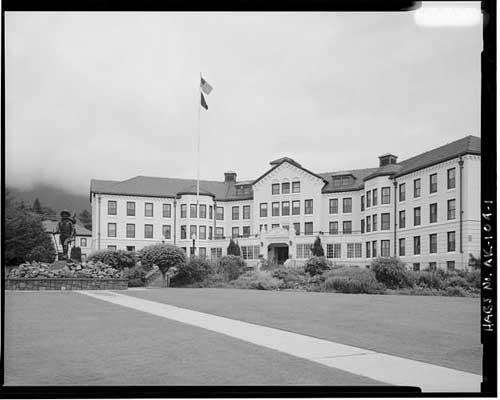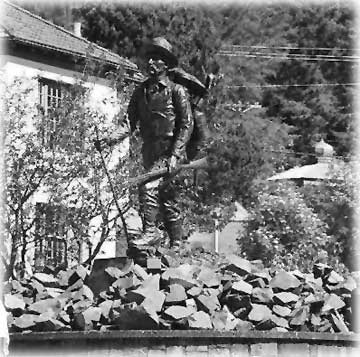 Sitka's Pioneer Home Statue Whose face is cast in bronze? By June Allen February 10, 2005

The larger-than-life bronze Alaskan sourdough carries a rifle as he stands atop the rocky bank of a prospect. His trousers are held up by a rope belt, and he is laden with a bronze pack that includes everything from pick and shovel to a coffee pot and tin cup. It's easy to imagine his sourdough starter kept warm in a leather pouch inside his shirt as well as tobacco stains on his drooping mustache. The confident expression on his face catches the pride of his pioneer determination and his Alaskan faith in the future. There have been good-natured arguments among Alaska's oldtimers for years about who might have been sculptor Alonzo Victor Lewis's model for the handsome face of that statue. Different towns had different ideas about who he was. They may have known it was said to be "Skagway Bill" Fonda, but that that didn't mean they had to believe it! That was especially true of the colorful oldtime fishermen at Meyers Chuck, for instance, who
Historical records specify that the model for the head of The Prospector was cast in the image of a real-life prospector named William "Skagway Bill" Fonda, a Gold Rush pioneer originally from Fonda, N.Y. Little is known of Alaska's Bill Fonda. His New York hometown was settled by Italian-Dutch immigrants in 1600. It is also the New York town from which the ancestors of movie actor Henry Fonda originated. The body segment of the Prospector statue, however, was modeled after someone other than Skagway Bill, his identity unknown. Sculptor Alonzo Victor Lewis is said to have "borrowed" the body from an earlier bronze he cast for Seattle's Alaska Yukon Pioneers organization. It was in 1926 that the Seattle Alaska Yukon Pioneers contacted the renowned sculptor to order a statue to commemorate the hardy Alaska-Yukon prospectors who were the organization's founders. Lewis then began work on a three-foot model of the statue-to-be, which he called The Sourdough. He used several individuals as models for the body portion of the smaller statue. The face, however, is said to bear a striking resemblance to George Carmack, one of the famous prospectors who made the first Klondike strike in 1896, sparking the Northern madness of the Alaska Gold Rush of '98. This small bronze statue today stands in Seattle's Klondike Gold Rush National Historical Park at Pioneer Square. When the smaller statue was finished, sculptor Lewis set about making the final 12-foot memorial version. More than three tons of clay were used for giant masterwork Originally it was a faithful replica of the smaller model. But before he completed it, Lewis removed Carmack's clay head and replaced it with the noble visage of "Skagway Bill" Fonda. However, the lengthy fund-raising efforts of Seattle's Alaska Yukon Pioneers proved slow and unsuccessful. Then in 1942 the statue committee of the Alaska Yukon Pioneers was disbanded and the second clay statue, still to be cast in bronze, stood in storage in the artist's studio. Four years later Alonzo Victor Lewis died, at age 59. His daughter, Charmain, purchased all of the art work in his studio, including the plaster cast of the big statue. No one remembers whose idea it was to buy the figure for Alaska's Sitka Pioneers Home, at that time the only such facility in Alaska. But the sculptor had family connections in Alaska. Alonzo Lewis's daughter, Charmain, had married Zalmain Gross, the eldest son of "Movie Man" William David Gross of Juneau. A number of Southeastern Alaska towns had and still have Gross Alaska theaters, including Ketchikan's Coliseum Theater. Maybe it was the elder Gross who floated the idea of Alaska's finding a way to have the statue for itself. Charmain and Zalmain Gross were Ketchikan residents at the Gross Apartments at 419 Grant St. during the World War II years. They managed the Coliseum while the Daiglers were in Juneau. The fund-raising effort to bring the statue north caught on, and Gross, himself a veteran of the rush north in 1897, was among many dedicated fund-raisers. Charmain Gross offered to donate the statue crafted by her father if funds could be raised to have it cast in bronze, shipped north, and erected on a suitable base. The always short-funded Territorial Legislature seemed to have a soft spot in its collective heart for projects connected to Alaska's pioneers. Some years before it had established a Pioneers Trust Fund into which contributions could be deposited for some future, undefined use. Gross recruited friends to help him in the efforts to lobby and convince the Territorial Legislature of the value and importance of the statue-acquisition project. Lending their weight to the discussions were Henry "Harry" Roden, who was the Senator from Idtarod in the very first Alaska Territorial Legislature in 1913, and Charles Carter, the Mayor of Juneau in those same, historic, early years. The three of them persuaded the 1947 Territorial Legislature to change the name and function of that fund to the Pioneer Monument Fund. And then even further funds were raised. By 1947 enough money was raised to have the statue cast in bronze and shipped to Sitka. Two years later the completed bronze monument was erected in front of the Pioneers Home, named The Prospector, and was dedicated on Alaska Day, Oct. 18, 1949. Today The Prospector is one of Sitka's most visited attractions. The monument is the embodiment of everything Alaska stands for 0 freedom, strength, confidence and courage as well as that indefinable element called "the spirit of adventure."
All rights reserved. Not to be reprinted in any form without the written permission of June Allen.
|






